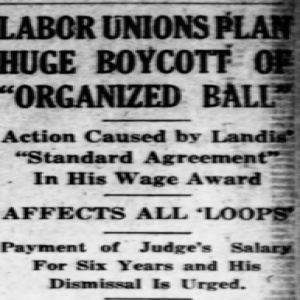
https://feed.podbean.com/laborhistoryin2/feed.xml
A daily, pocket-sized history of America's working people, brought to you by The Rick Smith Show team.
Monday Jan 09, 2017
On this day in labor history, the year was 1922.
That was the day Chicago Building Trades began to split over the much-hated Landis Award.
The Building Trades had always enjoyed strong solidarity built through years of sympathy strike action.
By 1921, they were involved in a bitter dispute with the city’s employers, who had been on the open-shop offensive since the end of the World War I.
Contractors attempted to impose deep wage cuts and instituted a lockout when the Building Trades refused to go along.
Judge Kenesaw Landis, who sent close to one hundred IWW members to prison during World War I, arbitrated the dispute and issued his award that fall.
Considered a major blow to the building trades, his award outlined eight points on behalf of employers.
It imposed deep wage cuts of anywhere from 15%-40%, practically abolished the right to strike, and undermined years of established work rules.
As the Chicago Federation of Labor and Building Trades Council geared up for the fight, the employers created their own “Citizens Committee” to enforce the award.
The Chicago Federation of Labor noted that of the Committee’s 176 members, only 54 were based in the city and of those, only one had any connection with the industry.
On this day, the CBTC called for a strike.
Some unions refused to abide by the call.
The Building Trades split, with the Carpenters and Painters among those in favor of striking versus the Bricklayers, Electricians and Ironworkers, voting to honor the award.
A reported 60,000 building tradesmen walked off the job anyway, but the strike soon failed.
The Trades continued to erode the award’s strength and by 1926, many local agreements simply superseded its enforcement.
More Episodes
 2024-11-06
2024-11-06
 2024-11-05
2024-11-05
 2024-11-04
2024-11-04
 2024-11-03
2024-11-03
 2024-11-02
2024-11-02
 2024-11-01
2024-11-01
 2024-11-01
2024-11-01
 2024-11-01
2024-11-01
 2024-11-01
2024-11-01
 2024-11-01
2024-11-01
 2024-11-01
2024-11-01
 2024-10-21
2024-10-21
 2024-10-18
2024-10-18
Create your
podcast in
minutes
- Full-featured podcast site
- Unlimited storage and bandwidth
- Comprehensive podcast stats
- Distribute to Apple Podcasts, Spotify, and more
- Make money with your podcast
It is Free
- Privacy Policy
- Cookie Policy
- Terms of Use
- Consent Preferences
- Copyright © 2015-2024 Podbean.com




